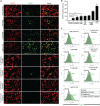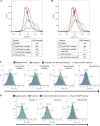FoxO1 Suppresses Kaposi's Sarcoma-Associated Herpesvirus Lytic Replication and Controls Viral Latency
- PMID: 30404794
- PMCID: PMC6340022
- DOI: 10.1128/JVI.01681-18
FoxO1 Suppresses Kaposi's Sarcoma-Associated Herpesvirus Lytic Replication and Controls Viral Latency
Abstract
Kaposi's sarcoma-associated herpesvirus (KSHV) has latent and lytic replication phases, both of which contribute to the development of KSHV-induced malignancies. Among the numerous factors identified to regulate the KSHV life cycle, oxidative stress, caused by imbalanced clearing and production of reactive oxygen species (ROS), has been shown to robustly disrupt KSHV latency and induce viral lytic replication. In this study, we identified an important role of the antioxidant defense factor forkhead box protein O1 (FoxO1) in the KSHV life cycle. Either chemical inhibition of the FoxO1 function or knockdown of FoxO1 expression led to an increase in the intracellular ROS level that was subsequently sufficient to disrupt KSHV latency and induce viral lytic reactivation. On the other hand, treatment with N-acetyl-l-cysteine (NAC), an oxygen free radical scavenger, led to a reduction in the FoxO1 inhibition-induced ROS level and, ultimately, the attenuation of KSHV lytic reactivation. These findings reveal that FoxO1 plays a critical role in keeping KSHV latency in check by maintaining the intracellular redox balance.IMPORTANCE Kaposi's sarcoma-associated herpesvirus (KSHV) is associated with several cancers, including Kaposi's sarcoma (KS). Both the KSHV latent and lytic replication phases are important for the development of KS. Identification of factors regulating the KSHV latent phase-to-lytic phase switch can provide insights into the pathogenesis of KSHV-induced malignancies. In this study, we show that the antioxidant defense factor forkhead box protein O1 (FoxO1) maintains KSHV latency by suppressing viral lytic replication. Inhibition of FoxO1 disrupts KSHV latency and induces viral lytic replication by increasing the intracellular ROS level. Significantly, treatment with an oxygen free radical scavenger, N-acetyl-l-cysteine (NAC), attenuated the FoxO1 inhibition-induced intracellular ROS level and KSHV lytic replication. Our works reveal a critical role of FoxO1 in suppressing KSHV lytic replication, which could be targeted for antiviral therapy.
Copyright © 2019 American Society for Microbiology.
Figures




Similar articles
-
Glycolysis, Glutaminolysis, and Fatty Acid Synthesis Are Required for Distinct Stages of Kaposi's Sarcoma-Associated Herpesvirus Lytic Replication.J Virol. 2017 Apr 28;91(10):e02237-16. doi: 10.1128/JVI.02237-16. Print 2017 May 15. J Virol. 2017. PMID: 28275189 Free PMC article.
-
Repurposing Cytarabine for Treating Primary Effusion Lymphoma by Targeting Kaposi's Sarcoma-Associated Herpesvirus Latent and Lytic Replications.mBio. 2018 May 8;9(3):e00756-18. doi: 10.1128/mBio.00756-18. mBio. 2018. PMID: 29739902 Free PMC article.
-
Polypharmacology-based kinome screen identifies new regulators of KSHV reactivation.bioRxiv [Preprint]. 2023 Feb 1:2023.02.01.526589. doi: 10.1101/2023.02.01.526589. bioRxiv. 2023. Update in: PLoS Pathog. 2023 Sep 5;19(9):e1011169. doi: 10.1371/journal.ppat.1011169. PMID: 36778430 Free PMC article. Updated. Preprint.
-
Unraveling the Kaposi Sarcoma-Associated Herpesvirus (KSHV) Lifecycle: An Overview of Latency, Lytic Replication, and KSHV-Associated Diseases.Viruses. 2025 Jan 26;17(2):177. doi: 10.3390/v17020177. Viruses. 2025. PMID: 40006930 Free PMC article. Review.
-
RNA Modifications and Their Role in Regulating KSHV Replication and Pathogenic Mechanisms.J Med Virol. 2025 Jan;97(1):e70140. doi: 10.1002/jmv.70140. J Med Virol. 2025. PMID: 39740054 Free PMC article. Review.
Cited by
-
KSHV hijacks FoxO1 to promote cell proliferation and cellular transformation by antagonizing oxidative stress.J Med Virol. 2023 Mar;95(3):e28676. doi: 10.1002/jmv.28676. J Med Virol. 2023. PMID: 36929740 Free PMC article.
-
METTL16 controls Kaposi's sarcoma-associated herpesvirus replication by regulating S-adenosylmethionine cycle.Cell Death Dis. 2023 Sep 6;14(9):591. doi: 10.1038/s41419-023-06121-3. Cell Death Dis. 2023. PMID: 37673880 Free PMC article.
-
Regulation of KSHV Latency and Lytic Reactivation.Viruses. 2020 Sep 17;12(9):1034. doi: 10.3390/v12091034. Viruses. 2020. PMID: 32957532 Free PMC article. Review.
-
Reactive oxygen species oxidize STING and suppress interferon production.Elife. 2020 Sep 4;9:e57837. doi: 10.7554/eLife.57837. Elife. 2020. PMID: 32886065 Free PMC article.
-
The regulation of KSHV lytic reactivation by viral and cellular factors.Curr Opin Virol. 2022 Feb;52:39-47. doi: 10.1016/j.coviro.2021.11.004. Epub 2021 Dec 3. Curr Opin Virol. 2022. PMID: 34872030 Free PMC article. Review.
References
-
- Cattelan AM, Calabro ML, De Rossi A, Aversa SM, Barbierato M, Trevenzoli M, Gasperini P, Zanchetta M, Cadrobbi P, Monfardini S, Chieco-Bianchi L. 2005. Long-term clinical outcome of AIDS-related Kaposi’s sarcoma during highly active antiretroviral therapy. Int J Oncol 27:779–785. - PubMed
-
- Cattelan AM, Calabro ML, Gasperini P, Aversa SM, Zanchetta M, Meneghetti F, De Rossi A, Chieco-Bianchi L. 2001. Acquired immunodeficiency syndrome-related Kaposi’s sarcoma regression after highly active antiretroviral therapy: biologic correlates of clinical outcome. J Natl Cancer Inst Monogr 2001:44–49. - PubMed
Publication types
MeSH terms
Substances
Grants and funding
- R01 CA197153/CA/NCI NIH HHS/United States
- R01 CA082057/CA/NCI NIH HHS/United States
- R01 DE025465/DE/NIDCR NIH HHS/United States
- R01 CA177377/CA/NCI NIH HHS/United States
- R01 AI073099/AI/NIAID NIH HHS/United States
- R01 CA132637/CA/NCI NIH HHS/United States
- R35 CA200422/CA/NCI NIH HHS/United States
- R01 HL110609/HL/NHLBI NIH HHS/United States
- R01 CA096512/CA/NCI NIH HHS/United States
- R01 CA124332/CA/NCI NIH HHS/United States
- R01 AI116585/AI/NIAID NIH HHS/United States
- R01 CA213275/CA/NCI NIH HHS/United States
- R01 DE023926/DE/NIDCR NIH HHS/United States
- P01 CA180779/CA/NCI NIH HHS/United States
LinkOut - more resources
Full Text Sources
Medical
Research Materials
Miscellaneous

